Understanding and Leading Change at AEGON: A Comprehensive Report
VerifiedAdded on 2021/02/20
|11
|3406
|39
Report
AI Summary
This report examines change management within the AEGON company, a life insurance, pension, and assets management organization. It analyzes the impact of change on AEGON's strategy and operations, comparing it to competitors like The Hartford, and explores both internal and external drivers of change, such as employee morale, organizational culture, political and economic factors. The report further discusses measures to minimize the negative impacts of change, including the PDCA model, and identifies barriers to change using the force field model. Different leadership approaches for dealing with change are also evaluated, providing a comprehensive overview of how AEGON can effectively navigate and lead organizational transformation. This report provides a detailed understanding of how AEGON implements change management strategies to improve performance and adapt to market dynamics.
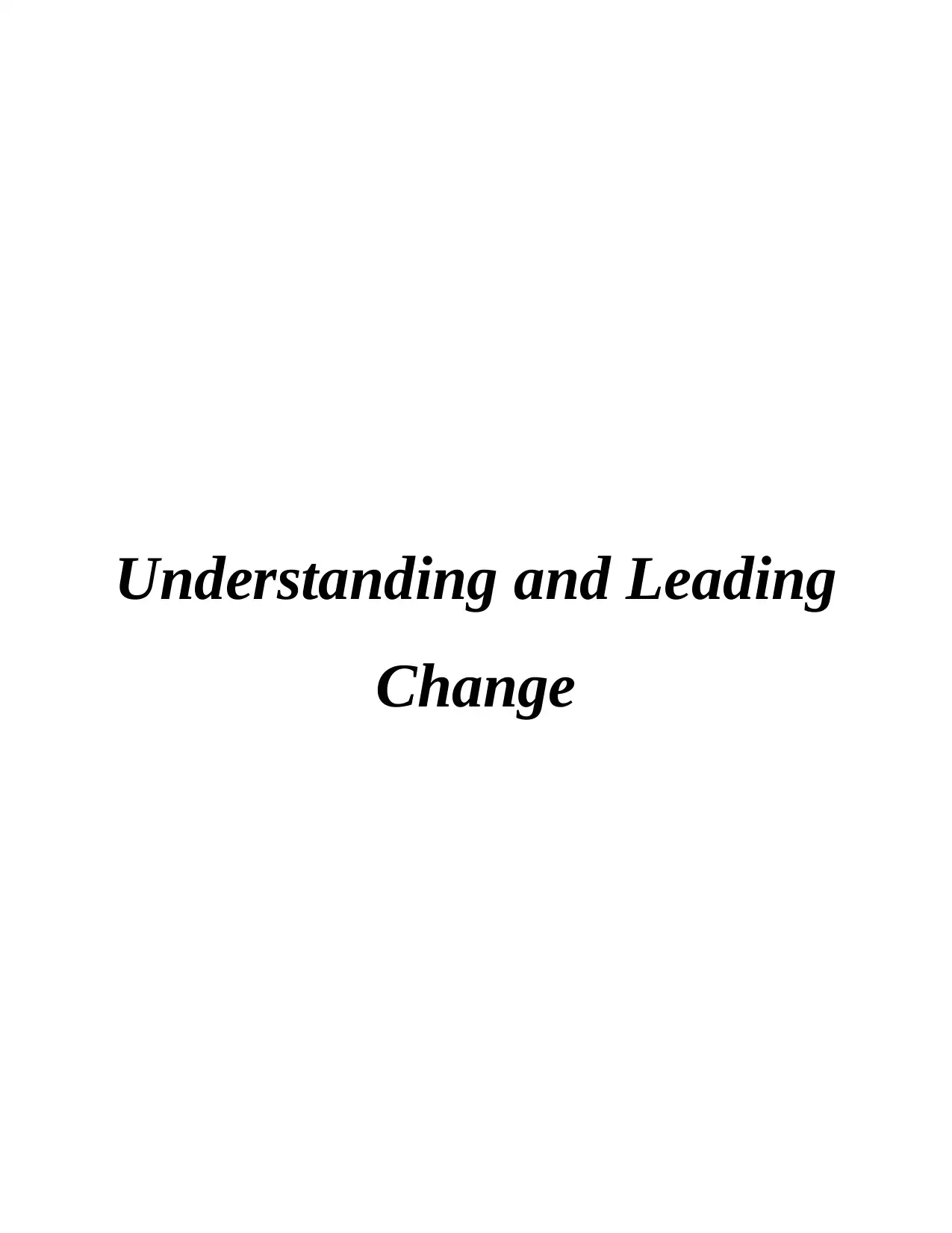
Understanding and Leading
Change
Change
Paraphrase This Document
Need a fresh take? Get an instant paraphrase of this document with our AI Paraphraser
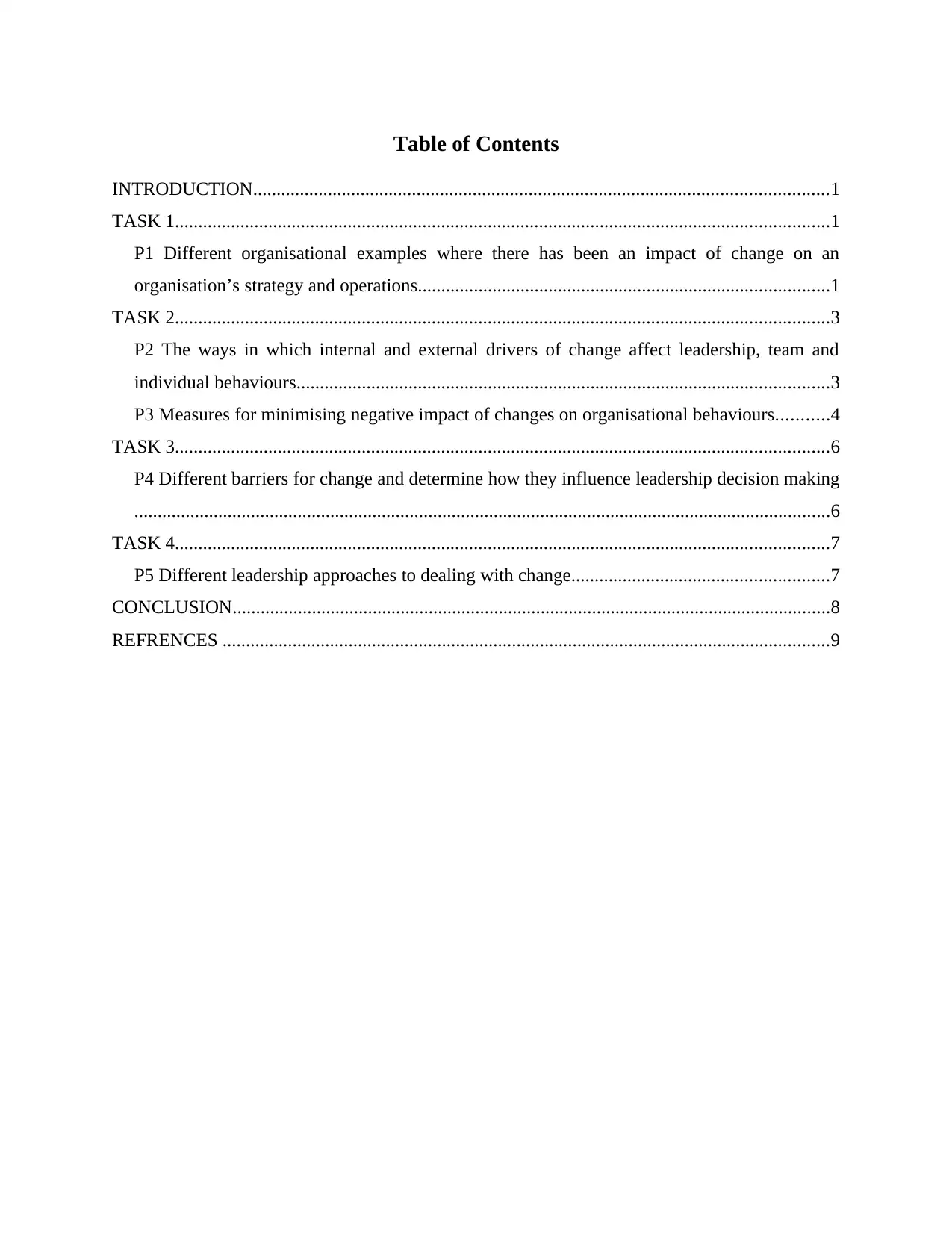
Table of Contents
INTRODUCTION...........................................................................................................................1
TASK 1............................................................................................................................................1
P1 Different organisational examples where there has been an impact of change on an
organisation’s strategy and operations........................................................................................1
TASK 2............................................................................................................................................3
P2 The ways in which internal and external drivers of change affect leadership, team and
individual behaviours..................................................................................................................3
P3 Measures for minimising negative impact of changes on organisational behaviours...........4
TASK 3............................................................................................................................................6
P4 Different barriers for change and determine how they influence leadership decision making
.....................................................................................................................................................6
TASK 4............................................................................................................................................7
P5 Different leadership approaches to dealing with change.......................................................7
CONCLUSION................................................................................................................................8
REFRENCES ..................................................................................................................................9
INTRODUCTION...........................................................................................................................1
TASK 1............................................................................................................................................1
P1 Different organisational examples where there has been an impact of change on an
organisation’s strategy and operations........................................................................................1
TASK 2............................................................................................................................................3
P2 The ways in which internal and external drivers of change affect leadership, team and
individual behaviours..................................................................................................................3
P3 Measures for minimising negative impact of changes on organisational behaviours...........4
TASK 3............................................................................................................................................6
P4 Different barriers for change and determine how they influence leadership decision making
.....................................................................................................................................................6
TASK 4............................................................................................................................................7
P5 Different leadership approaches to dealing with change.......................................................7
CONCLUSION................................................................................................................................8
REFRENCES ..................................................................................................................................9
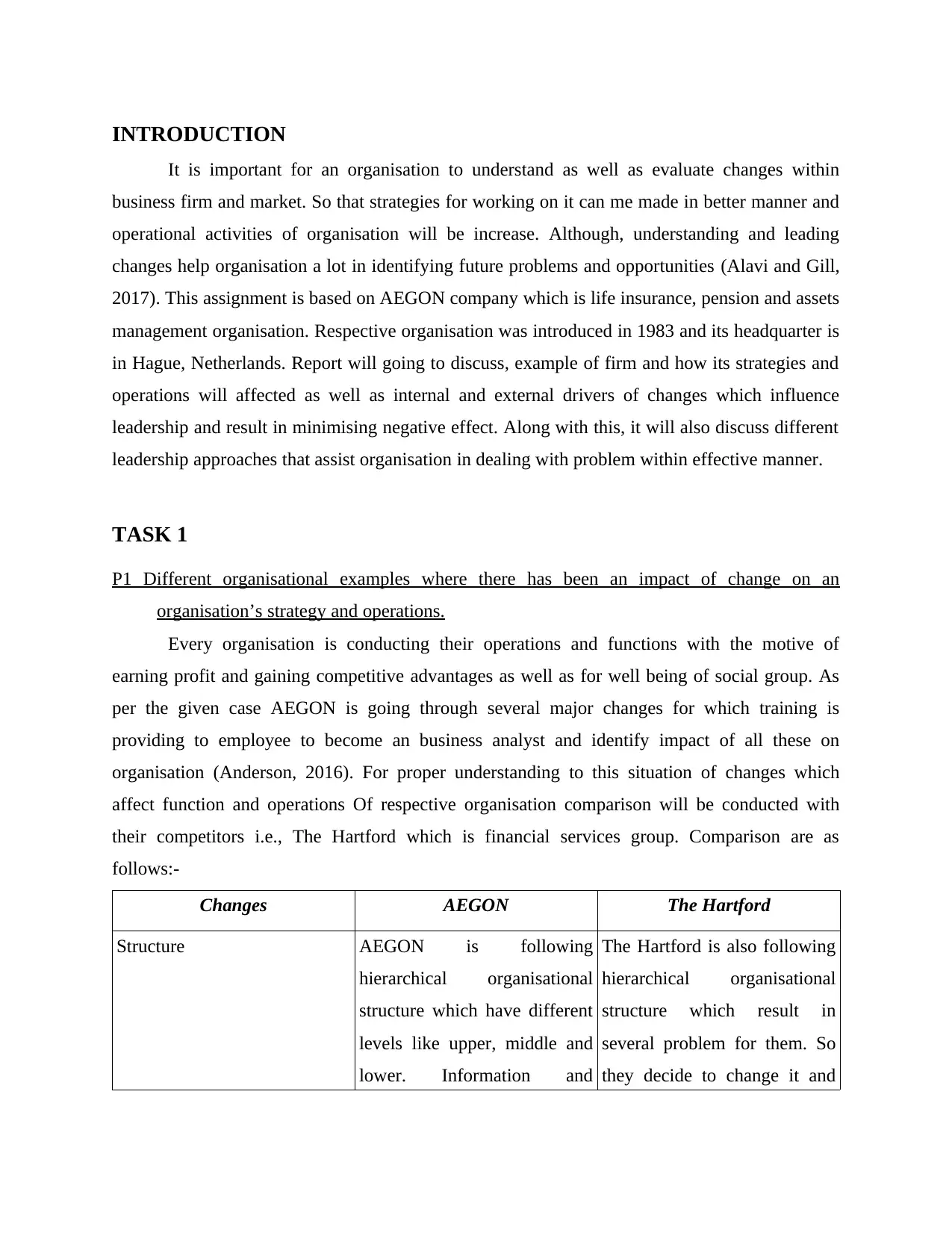
INTRODUCTION
It is important for an organisation to understand as well as evaluate changes within
business firm and market. So that strategies for working on it can me made in better manner and
operational activities of organisation will be increase. Although, understanding and leading
changes help organisation a lot in identifying future problems and opportunities (Alavi and Gill,
2017). This assignment is based on AEGON company which is life insurance, pension and assets
management organisation. Respective organisation was introduced in 1983 and its headquarter is
in Hague, Netherlands. Report will going to discuss, example of firm and how its strategies and
operations will affected as well as internal and external drivers of changes which influence
leadership and result in minimising negative effect. Along with this, it will also discuss different
leadership approaches that assist organisation in dealing with problem within effective manner.
TASK 1
P1 Different organisational examples where there has been an impact of change on an
organisation’s strategy and operations.
Every organisation is conducting their operations and functions with the motive of
earning profit and gaining competitive advantages as well as for well being of social group. As
per the given case AEGON is going through several major changes for which training is
providing to employee to become an business analyst and identify impact of all these on
organisation (Anderson, 2016). For proper understanding to this situation of changes which
affect function and operations Of respective organisation comparison will be conducted with
their competitors i.e., The Hartford which is financial services group. Comparison are as
follows:-
Changes AEGON The Hartford
Structure AEGON is following
hierarchical organisational
structure which have different
levels like upper, middle and
lower. Information and
The Hartford is also following
hierarchical organisational
structure which result in
several problem for them. So
they decide to change it and
It is important for an organisation to understand as well as evaluate changes within
business firm and market. So that strategies for working on it can me made in better manner and
operational activities of organisation will be increase. Although, understanding and leading
changes help organisation a lot in identifying future problems and opportunities (Alavi and Gill,
2017). This assignment is based on AEGON company which is life insurance, pension and assets
management organisation. Respective organisation was introduced in 1983 and its headquarter is
in Hague, Netherlands. Report will going to discuss, example of firm and how its strategies and
operations will affected as well as internal and external drivers of changes which influence
leadership and result in minimising negative effect. Along with this, it will also discuss different
leadership approaches that assist organisation in dealing with problem within effective manner.
TASK 1
P1 Different organisational examples where there has been an impact of change on an
organisation’s strategy and operations.
Every organisation is conducting their operations and functions with the motive of
earning profit and gaining competitive advantages as well as for well being of social group. As
per the given case AEGON is going through several major changes for which training is
providing to employee to become an business analyst and identify impact of all these on
organisation (Anderson, 2016). For proper understanding to this situation of changes which
affect function and operations Of respective organisation comparison will be conducted with
their competitors i.e., The Hartford which is financial services group. Comparison are as
follows:-
Changes AEGON The Hartford
Structure AEGON is following
hierarchical organisational
structure which have different
levels like upper, middle and
lower. Information and
The Hartford is also following
hierarchical organisational
structure which result in
several problem for them. So
they decide to change it and
⊘ This is a preview!⊘
Do you want full access?
Subscribe today to unlock all pages.

Trusted by 1+ million students worldwide
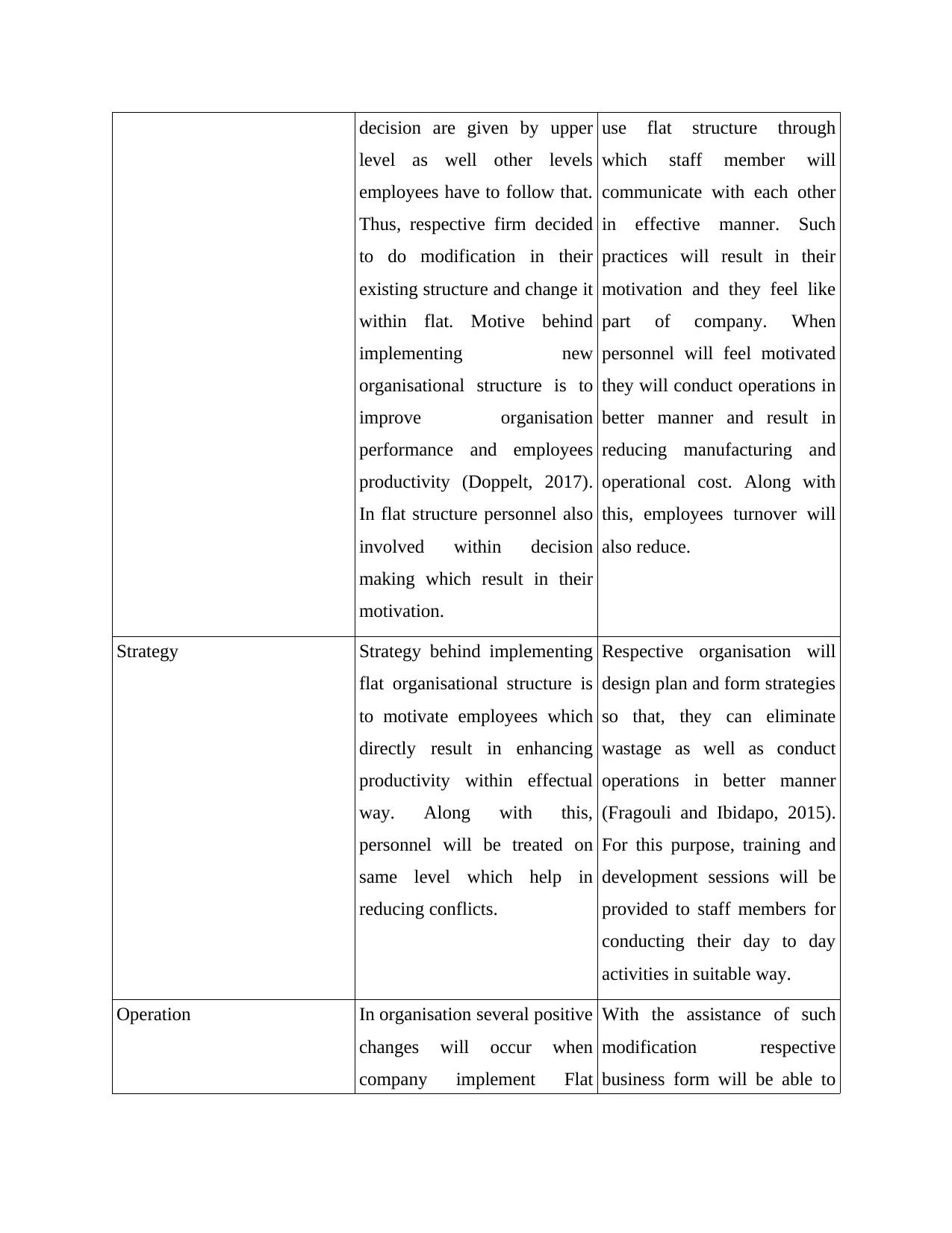
decision are given by upper
level as well other levels
employees have to follow that.
Thus, respective firm decided
to do modification in their
existing structure and change it
within flat. Motive behind
implementing new
organisational structure is to
improve organisation
performance and employees
productivity (Doppelt, 2017).
In flat structure personnel also
involved within decision
making which result in their
motivation.
use flat structure through
which staff member will
communicate with each other
in effective manner. Such
practices will result in their
motivation and they feel like
part of company. When
personnel will feel motivated
they will conduct operations in
better manner and result in
reducing manufacturing and
operational cost. Along with
this, employees turnover will
also reduce.
Strategy Strategy behind implementing
flat organisational structure is
to motivate employees which
directly result in enhancing
productivity within effectual
way. Along with this,
personnel will be treated on
same level which help in
reducing conflicts.
Respective organisation will
design plan and form strategies
so that, they can eliminate
wastage as well as conduct
operations in better manner
(Fragouli and Ibidapo, 2015).
For this purpose, training and
development sessions will be
provided to staff members for
conducting their day to day
activities in suitable way.
Operation In organisation several positive
changes will occur when
company implement Flat
With the assistance of such
modification respective
business form will be able to
level as well other levels
employees have to follow that.
Thus, respective firm decided
to do modification in their
existing structure and change it
within flat. Motive behind
implementing new
organisational structure is to
improve organisation
performance and employees
productivity (Doppelt, 2017).
In flat structure personnel also
involved within decision
making which result in their
motivation.
use flat structure through
which staff member will
communicate with each other
in effective manner. Such
practices will result in their
motivation and they feel like
part of company. When
personnel will feel motivated
they will conduct operations in
better manner and result in
reducing manufacturing and
operational cost. Along with
this, employees turnover will
also reduce.
Strategy Strategy behind implementing
flat organisational structure is
to motivate employees which
directly result in enhancing
productivity within effectual
way. Along with this,
personnel will be treated on
same level which help in
reducing conflicts.
Respective organisation will
design plan and form strategies
so that, they can eliminate
wastage as well as conduct
operations in better manner
(Fragouli and Ibidapo, 2015).
For this purpose, training and
development sessions will be
provided to staff members for
conducting their day to day
activities in suitable way.
Operation In organisation several positive
changes will occur when
company implement Flat
With the assistance of such
modification respective
business form will be able to
Paraphrase This Document
Need a fresh take? Get an instant paraphrase of this document with our AI Paraphraser
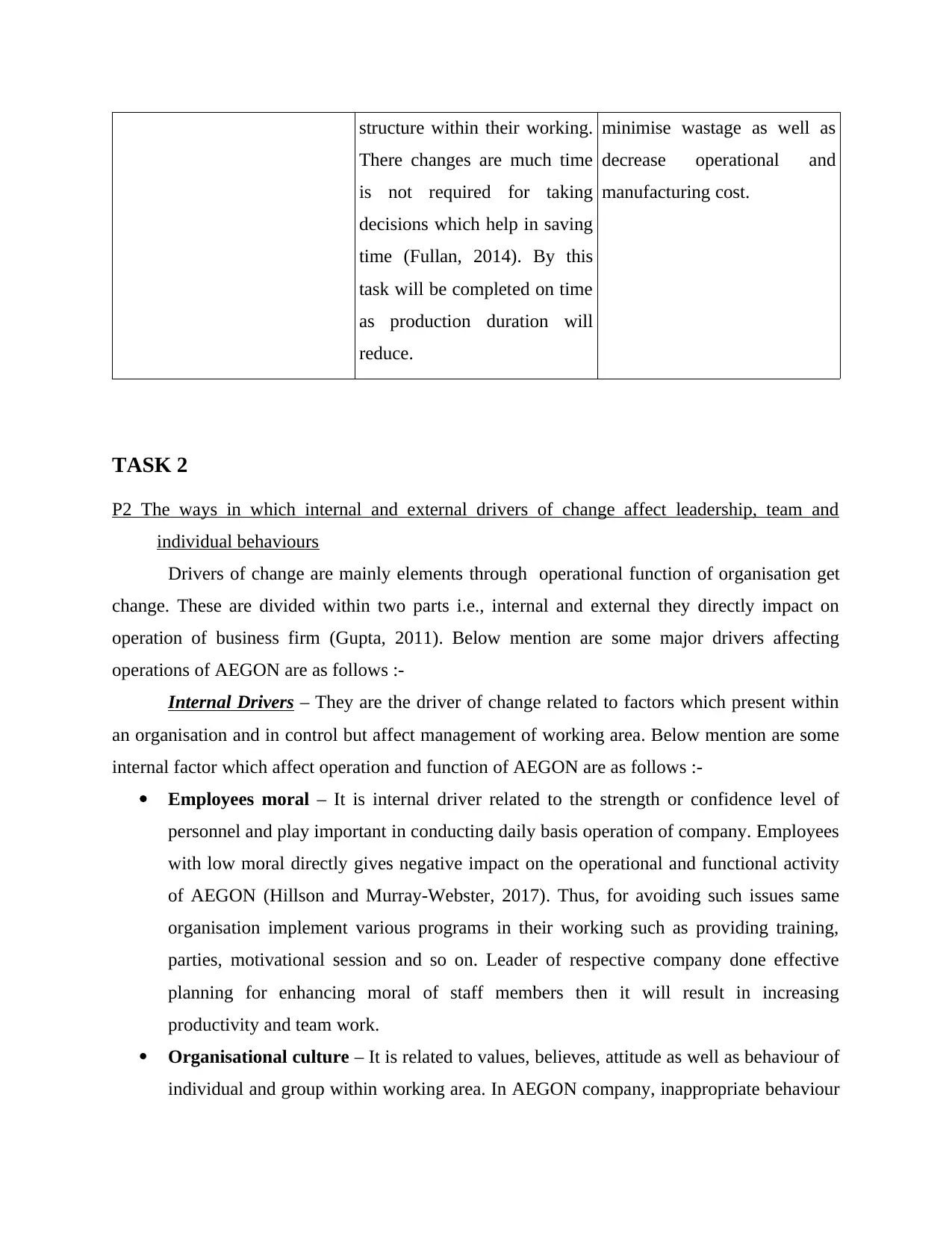
structure within their working.
There changes are much time
is not required for taking
decisions which help in saving
time (Fullan, 2014). By this
task will be completed on time
as production duration will
reduce.
minimise wastage as well as
decrease operational and
manufacturing cost.
TASK 2
P2 The ways in which internal and external drivers of change affect leadership, team and
individual behaviours
Drivers of change are mainly elements through operational function of organisation get
change. These are divided within two parts i.e., internal and external they directly impact on
operation of business firm (Gupta, 2011). Below mention are some major drivers affecting
operations of AEGON are as follows :-
Internal Drivers – They are the driver of change related to factors which present within
an organisation and in control but affect management of working area. Below mention are some
internal factor which affect operation and function of AEGON are as follows :-
Employees moral – It is internal driver related to the strength or confidence level of
personnel and play important in conducting daily basis operation of company. Employees
with low moral directly gives negative impact on the operational and functional activity
of AEGON (Hillson and Murray-Webster, 2017). Thus, for avoiding such issues same
organisation implement various programs in their working such as providing training,
parties, motivational session and so on. Leader of respective company done effective
planning for enhancing moral of staff members then it will result in increasing
productivity and team work.
Organisational culture – It is related to values, believes, attitude as well as behaviour of
individual and group within working area. In AEGON company, inappropriate behaviour
There changes are much time
is not required for taking
decisions which help in saving
time (Fullan, 2014). By this
task will be completed on time
as production duration will
reduce.
minimise wastage as well as
decrease operational and
manufacturing cost.
TASK 2
P2 The ways in which internal and external drivers of change affect leadership, team and
individual behaviours
Drivers of change are mainly elements through operational function of organisation get
change. These are divided within two parts i.e., internal and external they directly impact on
operation of business firm (Gupta, 2011). Below mention are some major drivers affecting
operations of AEGON are as follows :-
Internal Drivers – They are the driver of change related to factors which present within
an organisation and in control but affect management of working area. Below mention are some
internal factor which affect operation and function of AEGON are as follows :-
Employees moral – It is internal driver related to the strength or confidence level of
personnel and play important in conducting daily basis operation of company. Employees
with low moral directly gives negative impact on the operational and functional activity
of AEGON (Hillson and Murray-Webster, 2017). Thus, for avoiding such issues same
organisation implement various programs in their working such as providing training,
parties, motivational session and so on. Leader of respective company done effective
planning for enhancing moral of staff members then it will result in increasing
productivity and team work.
Organisational culture – It is related to values, believes, attitude as well as behaviour of
individual and group within working area. In AEGON company, inappropriate behaviour
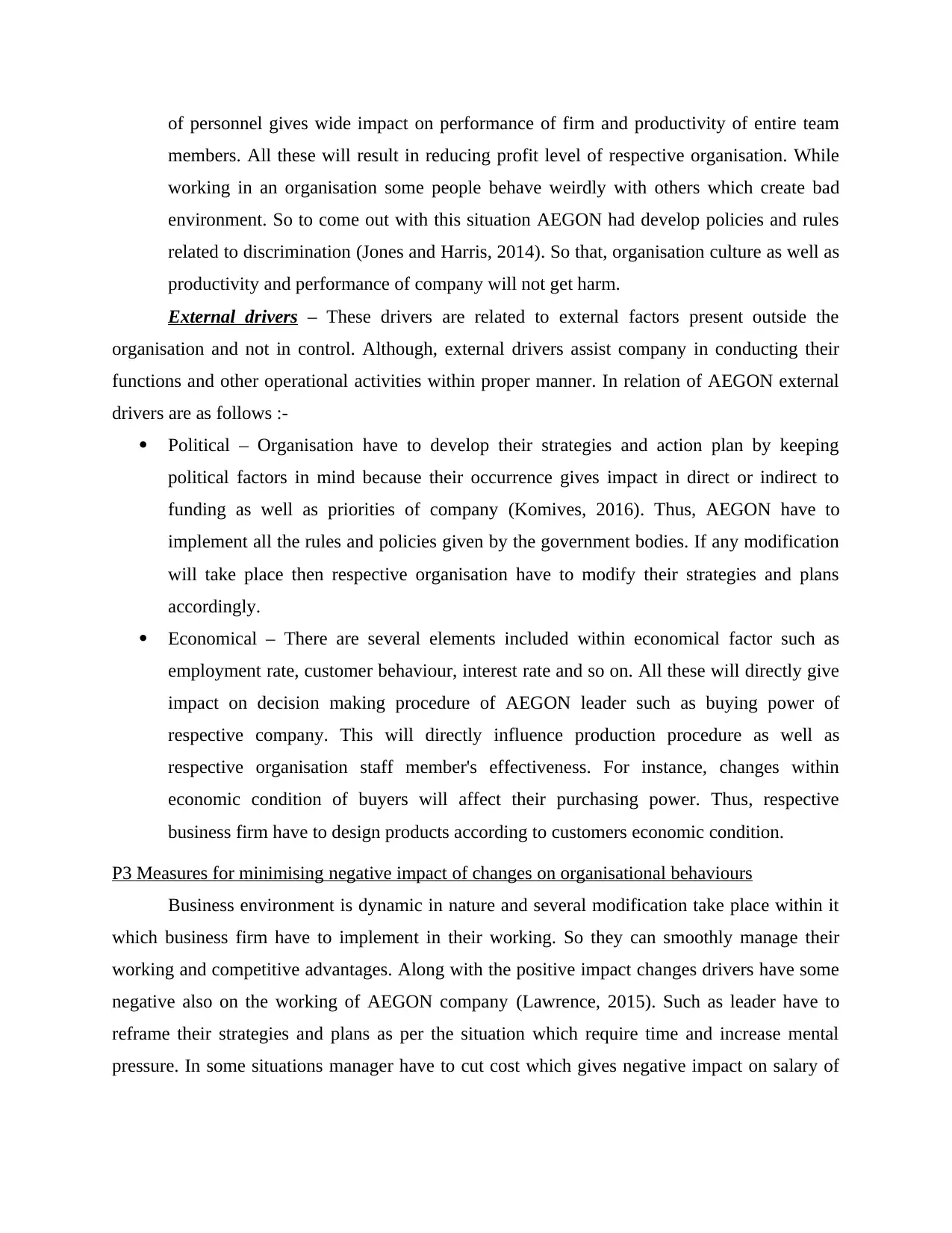
of personnel gives wide impact on performance of firm and productivity of entire team
members. All these will result in reducing profit level of respective organisation. While
working in an organisation some people behave weirdly with others which create bad
environment. So to come out with this situation AEGON had develop policies and rules
related to discrimination (Jones and Harris, 2014). So that, organisation culture as well as
productivity and performance of company will not get harm.
External drivers – These drivers are related to external factors present outside the
organisation and not in control. Although, external drivers assist company in conducting their
functions and other operational activities within proper manner. In relation of AEGON external
drivers are as follows :-
Political – Organisation have to develop their strategies and action plan by keeping
political factors in mind because their occurrence gives impact in direct or indirect to
funding as well as priorities of company (Komives, 2016). Thus, AEGON have to
implement all the rules and policies given by the government bodies. If any modification
will take place then respective organisation have to modify their strategies and plans
accordingly.
Economical – There are several elements included within economical factor such as
employment rate, customer behaviour, interest rate and so on. All these will directly give
impact on decision making procedure of AEGON leader such as buying power of
respective company. This will directly influence production procedure as well as
respective organisation staff member's effectiveness. For instance, changes within
economic condition of buyers will affect their purchasing power. Thus, respective
business firm have to design products according to customers economic condition.
P3 Measures for minimising negative impact of changes on organisational behaviours
Business environment is dynamic in nature and several modification take place within it
which business firm have to implement in their working. So they can smoothly manage their
working and competitive advantages. Along with the positive impact changes drivers have some
negative also on the working of AEGON company (Lawrence, 2015). Such as leader have to
reframe their strategies and plans as per the situation which require time and increase mental
pressure. In some situations manager have to cut cost which gives negative impact on salary of
members. All these will result in reducing profit level of respective organisation. While
working in an organisation some people behave weirdly with others which create bad
environment. So to come out with this situation AEGON had develop policies and rules
related to discrimination (Jones and Harris, 2014). So that, organisation culture as well as
productivity and performance of company will not get harm.
External drivers – These drivers are related to external factors present outside the
organisation and not in control. Although, external drivers assist company in conducting their
functions and other operational activities within proper manner. In relation of AEGON external
drivers are as follows :-
Political – Organisation have to develop their strategies and action plan by keeping
political factors in mind because their occurrence gives impact in direct or indirect to
funding as well as priorities of company (Komives, 2016). Thus, AEGON have to
implement all the rules and policies given by the government bodies. If any modification
will take place then respective organisation have to modify their strategies and plans
accordingly.
Economical – There are several elements included within economical factor such as
employment rate, customer behaviour, interest rate and so on. All these will directly give
impact on decision making procedure of AEGON leader such as buying power of
respective company. This will directly influence production procedure as well as
respective organisation staff member's effectiveness. For instance, changes within
economic condition of buyers will affect their purchasing power. Thus, respective
business firm have to design products according to customers economic condition.
P3 Measures for minimising negative impact of changes on organisational behaviours
Business environment is dynamic in nature and several modification take place within it
which business firm have to implement in their working. So they can smoothly manage their
working and competitive advantages. Along with the positive impact changes drivers have some
negative also on the working of AEGON company (Lawrence, 2015). Such as leader have to
reframe their strategies and plans as per the situation which require time and increase mental
pressure. In some situations manager have to cut cost which gives negative impact on salary of
⊘ This is a preview!⊘
Do you want full access?
Subscribe today to unlock all pages.

Trusted by 1+ million students worldwide
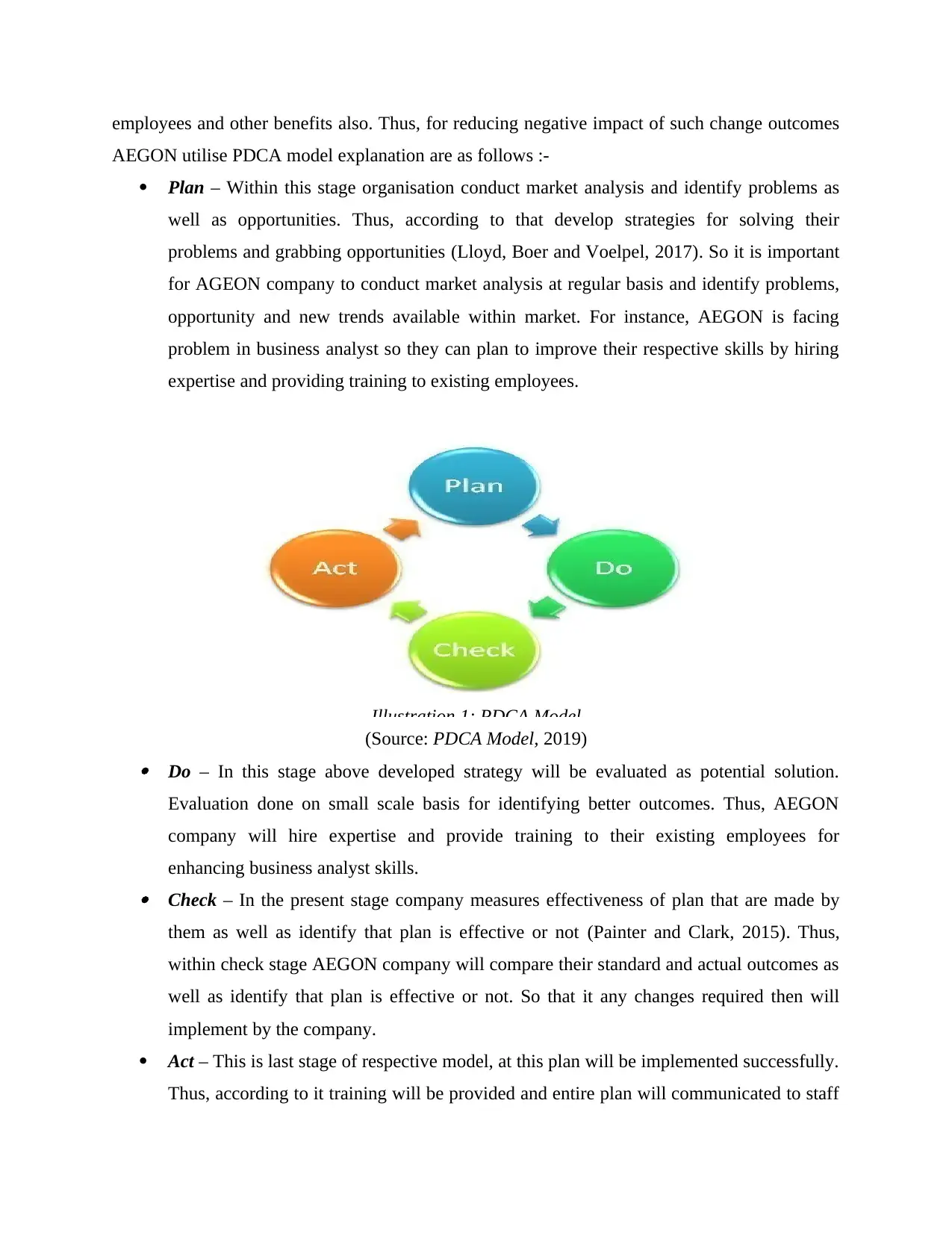
employees and other benefits also. Thus, for reducing negative impact of such change outcomes
AEGON utilise PDCA model explanation are as follows :-
Plan – Within this stage organisation conduct market analysis and identify problems as
well as opportunities. Thus, according to that develop strategies for solving their
problems and grabbing opportunities (Lloyd, Boer and Voelpel, 2017). So it is important
for AGEON company to conduct market analysis at regular basis and identify problems,
opportunity and new trends available within market. For instance, AEGON is facing
problem in business analyst so they can plan to improve their respective skills by hiring
expertise and providing training to existing employees.
Illustration 1: PDCA Model
(Source: PDCA Model, 2019) Do – In this stage above developed strategy will be evaluated as potential solution.
Evaluation done on small scale basis for identifying better outcomes. Thus, AEGON
company will hire expertise and provide training to their existing employees for
enhancing business analyst skills. Check – In the present stage company measures effectiveness of plan that are made by
them as well as identify that plan is effective or not (Painter and Clark, 2015). Thus,
within check stage AEGON company will compare their standard and actual outcomes as
well as identify that plan is effective or not. So that it any changes required then will
implement by the company.
Act – This is last stage of respective model, at this plan will be implemented successfully.
Thus, according to it training will be provided and entire plan will communicated to staff
AEGON utilise PDCA model explanation are as follows :-
Plan – Within this stage organisation conduct market analysis and identify problems as
well as opportunities. Thus, according to that develop strategies for solving their
problems and grabbing opportunities (Lloyd, Boer and Voelpel, 2017). So it is important
for AGEON company to conduct market analysis at regular basis and identify problems,
opportunity and new trends available within market. For instance, AEGON is facing
problem in business analyst so they can plan to improve their respective skills by hiring
expertise and providing training to existing employees.
Illustration 1: PDCA Model
(Source: PDCA Model, 2019) Do – In this stage above developed strategy will be evaluated as potential solution.
Evaluation done on small scale basis for identifying better outcomes. Thus, AEGON
company will hire expertise and provide training to their existing employees for
enhancing business analyst skills. Check – In the present stage company measures effectiveness of plan that are made by
them as well as identify that plan is effective or not (Painter and Clark, 2015). Thus,
within check stage AEGON company will compare their standard and actual outcomes as
well as identify that plan is effective or not. So that it any changes required then will
implement by the company.
Act – This is last stage of respective model, at this plan will be implemented successfully.
Thus, according to it training will be provided and entire plan will communicated to staff
Paraphrase This Document
Need a fresh take? Get an instant paraphrase of this document with our AI Paraphraser
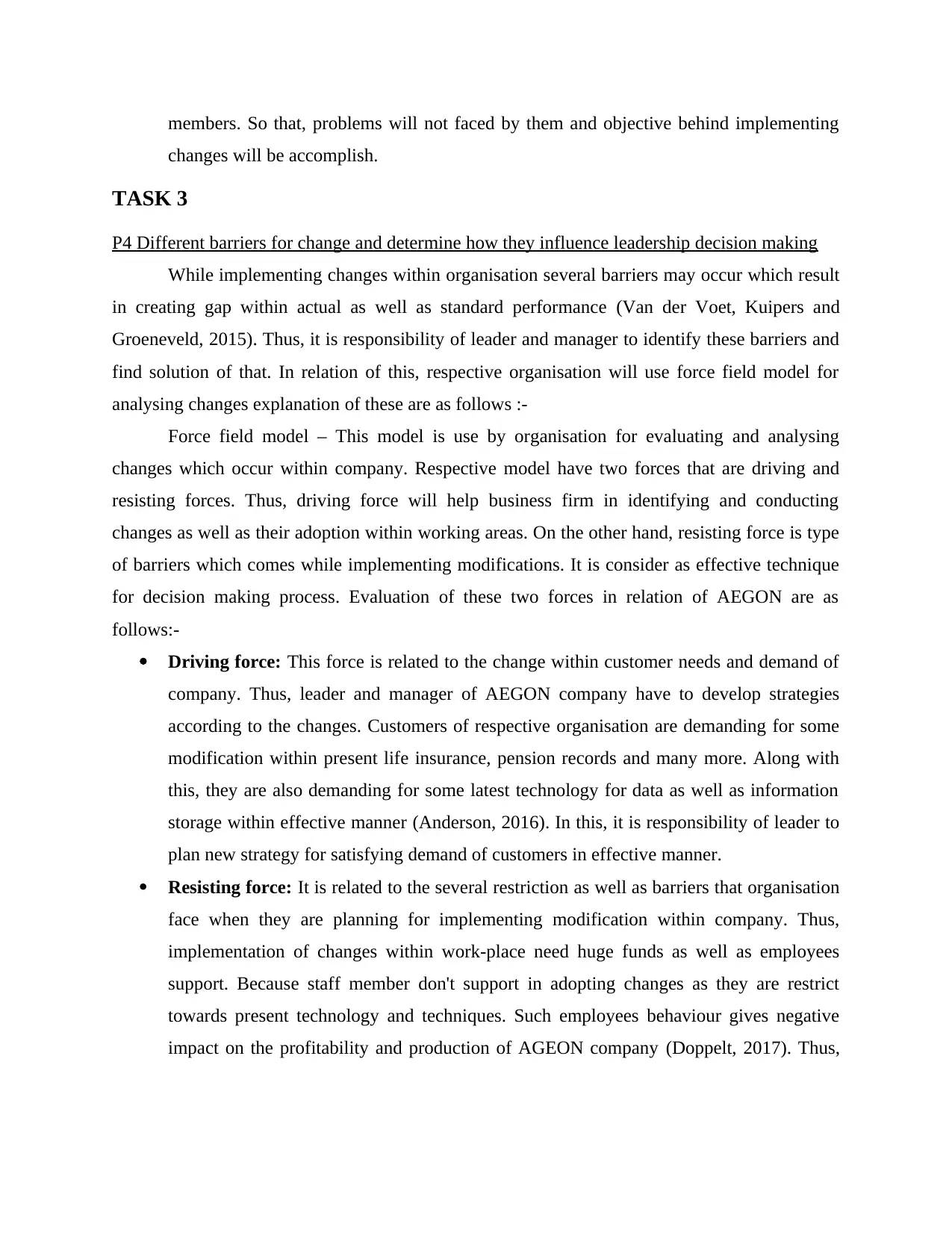
members. So that, problems will not faced by them and objective behind implementing
changes will be accomplish.
TASK 3
P4 Different barriers for change and determine how they influence leadership decision making
While implementing changes within organisation several barriers may occur which result
in creating gap within actual as well as standard performance (Van der Voet, Kuipers and
Groeneveld, 2015). Thus, it is responsibility of leader and manager to identify these barriers and
find solution of that. In relation of this, respective organisation will use force field model for
analysing changes explanation of these are as follows :-
Force field model – This model is use by organisation for evaluating and analysing
changes which occur within company. Respective model have two forces that are driving and
resisting forces. Thus, driving force will help business firm in identifying and conducting
changes as well as their adoption within working areas. On the other hand, resisting force is type
of barriers which comes while implementing modifications. It is consider as effective technique
for decision making process. Evaluation of these two forces in relation of AEGON are as
follows:-
Driving force: This force is related to the change within customer needs and demand of
company. Thus, leader and manager of AEGON company have to develop strategies
according to the changes. Customers of respective organisation are demanding for some
modification within present life insurance, pension records and many more. Along with
this, they are also demanding for some latest technology for data as well as information
storage within effective manner (Anderson, 2016). In this, it is responsibility of leader to
plan new strategy for satisfying demand of customers in effective manner.
Resisting force: It is related to the several restriction as well as barriers that organisation
face when they are planning for implementing modification within company. Thus,
implementation of changes within work-place need huge funds as well as employees
support. Because staff member don't support in adopting changes as they are restrict
towards present technology and techniques. Such employees behaviour gives negative
impact on the profitability and production of AGEON company (Doppelt, 2017). Thus,
changes will be accomplish.
TASK 3
P4 Different barriers for change and determine how they influence leadership decision making
While implementing changes within organisation several barriers may occur which result
in creating gap within actual as well as standard performance (Van der Voet, Kuipers and
Groeneveld, 2015). Thus, it is responsibility of leader and manager to identify these barriers and
find solution of that. In relation of this, respective organisation will use force field model for
analysing changes explanation of these are as follows :-
Force field model – This model is use by organisation for evaluating and analysing
changes which occur within company. Respective model have two forces that are driving and
resisting forces. Thus, driving force will help business firm in identifying and conducting
changes as well as their adoption within working areas. On the other hand, resisting force is type
of barriers which comes while implementing modifications. It is consider as effective technique
for decision making process. Evaluation of these two forces in relation of AEGON are as
follows:-
Driving force: This force is related to the change within customer needs and demand of
company. Thus, leader and manager of AEGON company have to develop strategies
according to the changes. Customers of respective organisation are demanding for some
modification within present life insurance, pension records and many more. Along with
this, they are also demanding for some latest technology for data as well as information
storage within effective manner (Anderson, 2016). In this, it is responsibility of leader to
plan new strategy for satisfying demand of customers in effective manner.
Resisting force: It is related to the several restriction as well as barriers that organisation
face when they are planning for implementing modification within company. Thus,
implementation of changes within work-place need huge funds as well as employees
support. Because staff member don't support in adopting changes as they are restrict
towards present technology and techniques. Such employees behaviour gives negative
impact on the profitability and production of AGEON company (Doppelt, 2017). Thus,
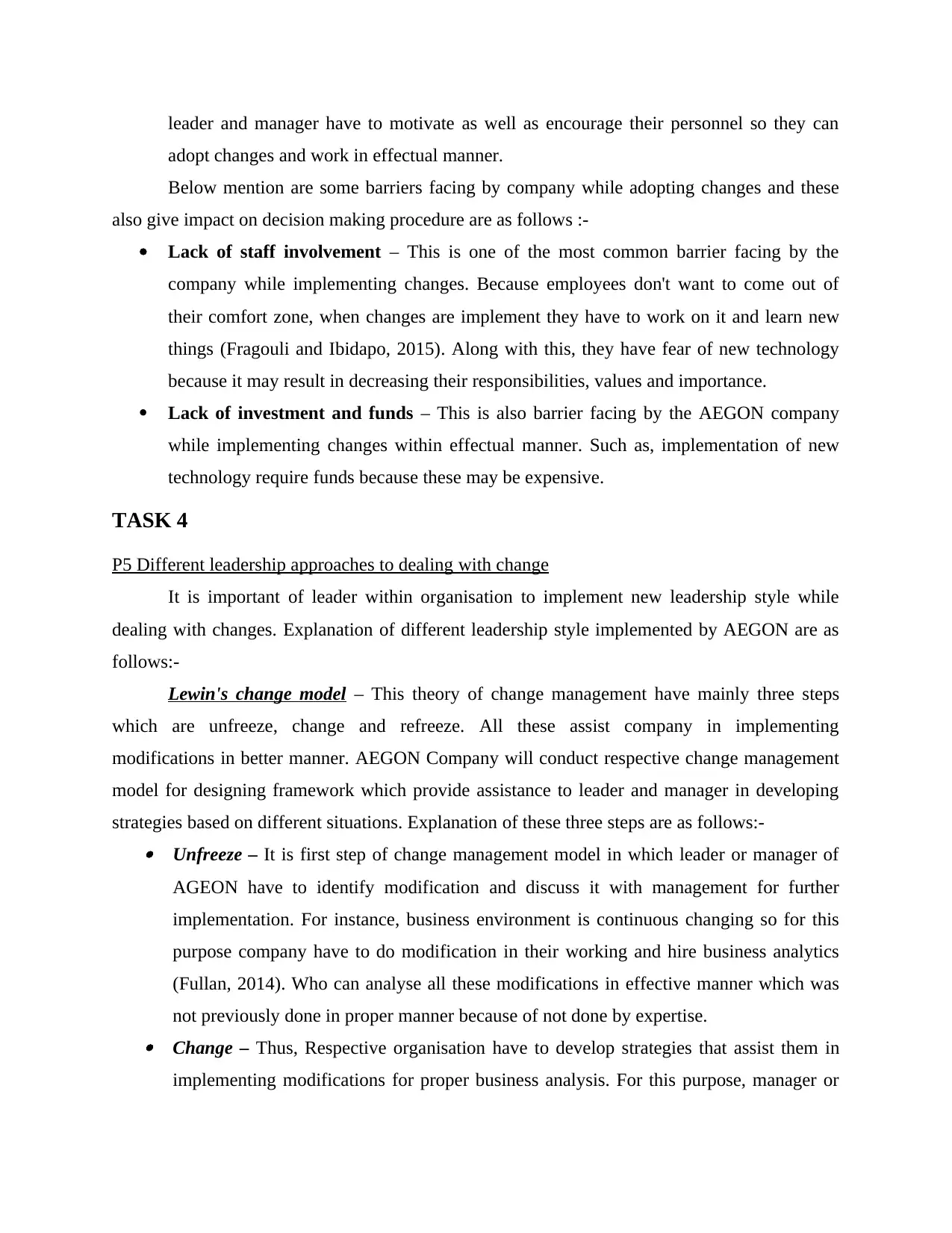
leader and manager have to motivate as well as encourage their personnel so they can
adopt changes and work in effectual manner.
Below mention are some barriers facing by company while adopting changes and these
also give impact on decision making procedure are as follows :-
Lack of staff involvement – This is one of the most common barrier facing by the
company while implementing changes. Because employees don't want to come out of
their comfort zone, when changes are implement they have to work on it and learn new
things (Fragouli and Ibidapo, 2015). Along with this, they have fear of new technology
because it may result in decreasing their responsibilities, values and importance.
Lack of investment and funds – This is also barrier facing by the AEGON company
while implementing changes within effectual manner. Such as, implementation of new
technology require funds because these may be expensive.
TASK 4
P5 Different leadership approaches to dealing with change
It is important of leader within organisation to implement new leadership style while
dealing with changes. Explanation of different leadership style implemented by AEGON are as
follows:-
Lewin's change model – This theory of change management have mainly three steps
which are unfreeze, change and refreeze. All these assist company in implementing
modifications in better manner. AEGON Company will conduct respective change management
model for designing framework which provide assistance to leader and manager in developing
strategies based on different situations. Explanation of these three steps are as follows:- Unfreeze – It is first step of change management model in which leader or manager of
AGEON have to identify modification and discuss it with management for further
implementation. For instance, business environment is continuous changing so for this
purpose company have to do modification in their working and hire business analytics
(Fullan, 2014). Who can analyse all these modifications in effective manner which was
not previously done in proper manner because of not done by expertise. Change – Thus, Respective organisation have to develop strategies that assist them in
implementing modifications for proper business analysis. For this purpose, manager or
adopt changes and work in effectual manner.
Below mention are some barriers facing by company while adopting changes and these
also give impact on decision making procedure are as follows :-
Lack of staff involvement – This is one of the most common barrier facing by the
company while implementing changes. Because employees don't want to come out of
their comfort zone, when changes are implement they have to work on it and learn new
things (Fragouli and Ibidapo, 2015). Along with this, they have fear of new technology
because it may result in decreasing their responsibilities, values and importance.
Lack of investment and funds – This is also barrier facing by the AEGON company
while implementing changes within effectual manner. Such as, implementation of new
technology require funds because these may be expensive.
TASK 4
P5 Different leadership approaches to dealing with change
It is important of leader within organisation to implement new leadership style while
dealing with changes. Explanation of different leadership style implemented by AEGON are as
follows:-
Lewin's change model – This theory of change management have mainly three steps
which are unfreeze, change and refreeze. All these assist company in implementing
modifications in better manner. AEGON Company will conduct respective change management
model for designing framework which provide assistance to leader and manager in developing
strategies based on different situations. Explanation of these three steps are as follows:- Unfreeze – It is first step of change management model in which leader or manager of
AGEON have to identify modification and discuss it with management for further
implementation. For instance, business environment is continuous changing so for this
purpose company have to do modification in their working and hire business analytics
(Fullan, 2014). Who can analyse all these modifications in effective manner which was
not previously done in proper manner because of not done by expertise. Change – Thus, Respective organisation have to develop strategies that assist them in
implementing modifications for proper business analysis. For this purpose, manager or
⊘ This is a preview!⊘
Do you want full access?
Subscribe today to unlock all pages.

Trusted by 1+ million students worldwide
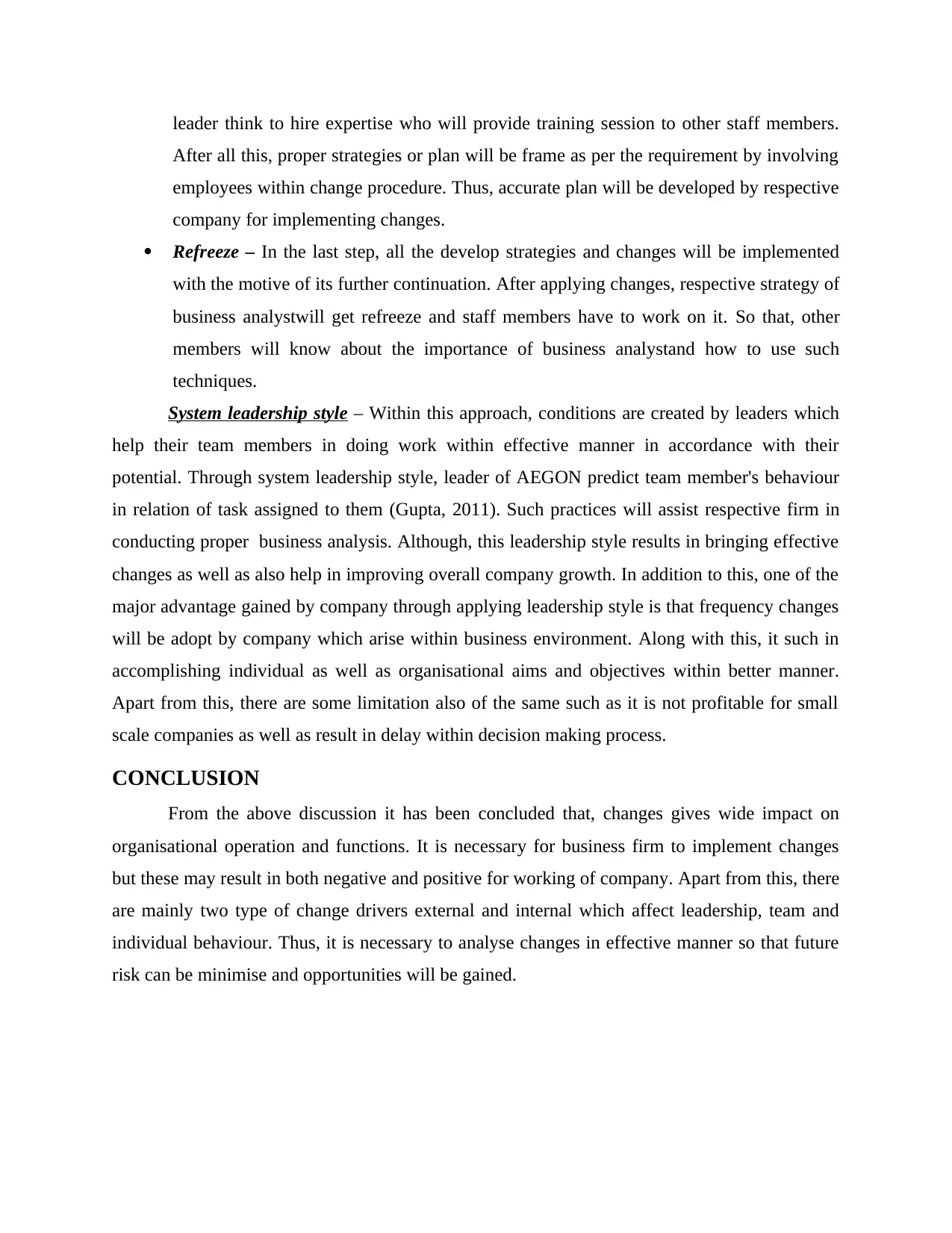
leader think to hire expertise who will provide training session to other staff members.
After all this, proper strategies or plan will be frame as per the requirement by involving
employees within change procedure. Thus, accurate plan will be developed by respective
company for implementing changes.
Refreeze – In the last step, all the develop strategies and changes will be implemented
with the motive of its further continuation. After applying changes, respective strategy of
business analystwill get refreeze and staff members have to work on it. So that, other
members will know about the importance of business analystand how to use such
techniques.
System leadership style – Within this approach, conditions are created by leaders which
help their team members in doing work within effective manner in accordance with their
potential. Through system leadership style, leader of AEGON predict team member's behaviour
in relation of task assigned to them (Gupta, 2011). Such practices will assist respective firm in
conducting proper business analysis. Although, this leadership style results in bringing effective
changes as well as also help in improving overall company growth. In addition to this, one of the
major advantage gained by company through applying leadership style is that frequency changes
will be adopt by company which arise within business environment. Along with this, it such in
accomplishing individual as well as organisational aims and objectives within better manner.
Apart from this, there are some limitation also of the same such as it is not profitable for small
scale companies as well as result in delay within decision making process.
CONCLUSION
From the above discussion it has been concluded that, changes gives wide impact on
organisational operation and functions. It is necessary for business firm to implement changes
but these may result in both negative and positive for working of company. Apart from this, there
are mainly two type of change drivers external and internal which affect leadership, team and
individual behaviour. Thus, it is necessary to analyse changes in effective manner so that future
risk can be minimise and opportunities will be gained.
After all this, proper strategies or plan will be frame as per the requirement by involving
employees within change procedure. Thus, accurate plan will be developed by respective
company for implementing changes.
Refreeze – In the last step, all the develop strategies and changes will be implemented
with the motive of its further continuation. After applying changes, respective strategy of
business analystwill get refreeze and staff members have to work on it. So that, other
members will know about the importance of business analystand how to use such
techniques.
System leadership style – Within this approach, conditions are created by leaders which
help their team members in doing work within effective manner in accordance with their
potential. Through system leadership style, leader of AEGON predict team member's behaviour
in relation of task assigned to them (Gupta, 2011). Such practices will assist respective firm in
conducting proper business analysis. Although, this leadership style results in bringing effective
changes as well as also help in improving overall company growth. In addition to this, one of the
major advantage gained by company through applying leadership style is that frequency changes
will be adopt by company which arise within business environment. Along with this, it such in
accomplishing individual as well as organisational aims and objectives within better manner.
Apart from this, there are some limitation also of the same such as it is not profitable for small
scale companies as well as result in delay within decision making process.
CONCLUSION
From the above discussion it has been concluded that, changes gives wide impact on
organisational operation and functions. It is necessary for business firm to implement changes
but these may result in both negative and positive for working of company. Apart from this, there
are mainly two type of change drivers external and internal which affect leadership, team and
individual behaviour. Thus, it is necessary to analyse changes in effective manner so that future
risk can be minimise and opportunities will be gained.
Paraphrase This Document
Need a fresh take? Get an instant paraphrase of this document with our AI Paraphraser
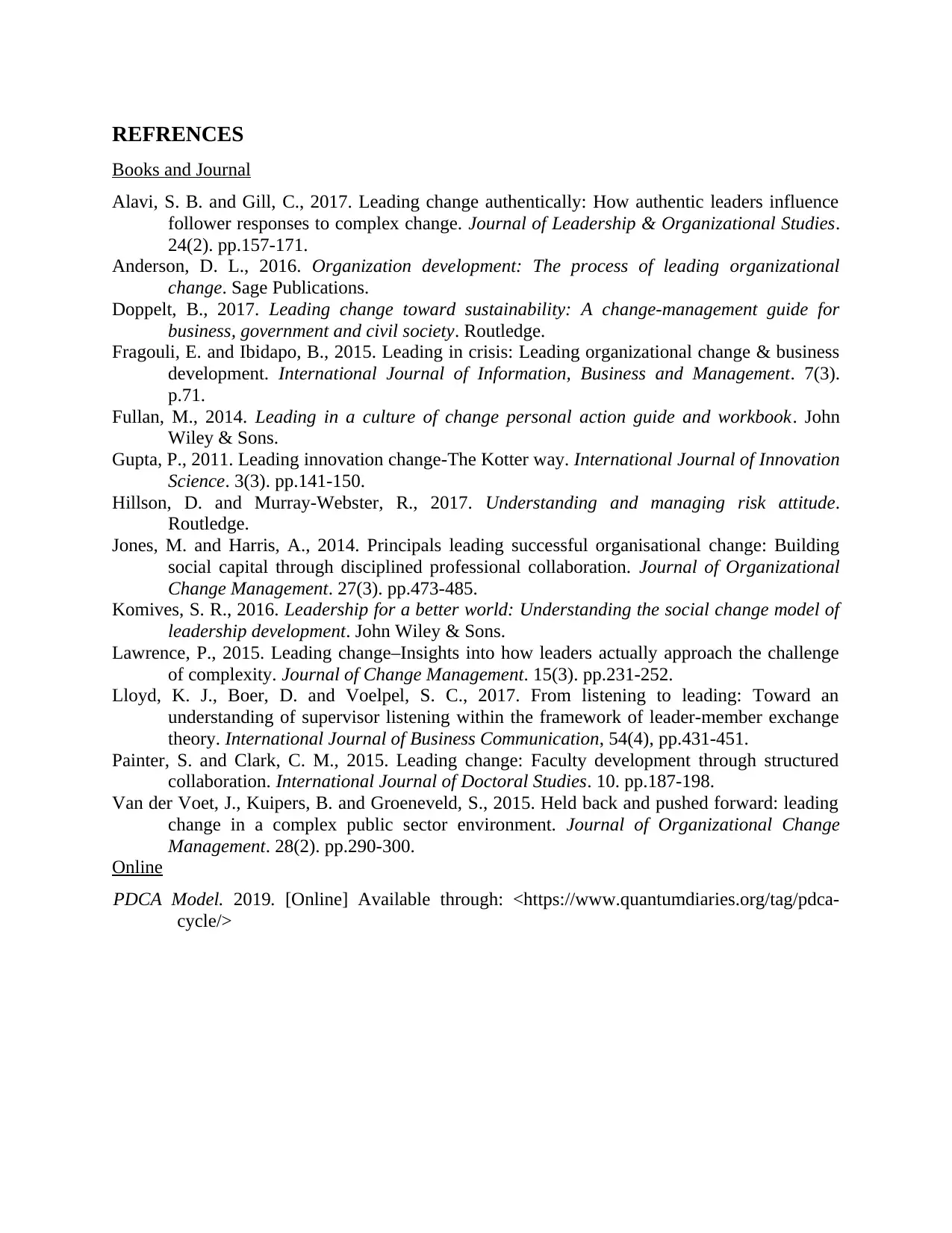
REFRENCES
Books and Journal
Alavi, S. B. and Gill, C., 2017. Leading change authentically: How authentic leaders influence
follower responses to complex change. Journal of Leadership & Organizational Studies.
24(2). pp.157-171.
Anderson, D. L., 2016. Organization development: The process of leading organizational
change. Sage Publications.
Doppelt, B., 2017. Leading change toward sustainability: A change-management guide for
business, government and civil society. Routledge.
Fragouli, E. and Ibidapo, B., 2015. Leading in crisis: Leading organizational change & business
development. International Journal of Information, Business and Management. 7(3).
p.71.
Fullan, M., 2014. Leading in a culture of change personal action guide and workbook. John
Wiley & Sons.
Gupta, P., 2011. Leading innovation change-The Kotter way. International Journal of Innovation
Science. 3(3). pp.141-150.
Hillson, D. and Murray-Webster, R., 2017. Understanding and managing risk attitude.
Routledge.
Jones, M. and Harris, A., 2014. Principals leading successful organisational change: Building
social capital through disciplined professional collaboration. Journal of Organizational
Change Management. 27(3). pp.473-485.
Komives, S. R., 2016. Leadership for a better world: Understanding the social change model of
leadership development. John Wiley & Sons.
Lawrence, P., 2015. Leading change–Insights into how leaders actually approach the challenge
of complexity. Journal of Change Management. 15(3). pp.231-252.
Lloyd, K. J., Boer, D. and Voelpel, S. C., 2017. From listening to leading: Toward an
understanding of supervisor listening within the framework of leader-member exchange
theory. International Journal of Business Communication, 54(4), pp.431-451.
Painter, S. and Clark, C. M., 2015. Leading change: Faculty development through structured
collaboration. International Journal of Doctoral Studies. 10. pp.187-198.
Van der Voet, J., Kuipers, B. and Groeneveld, S., 2015. Held back and pushed forward: leading
change in a complex public sector environment. Journal of Organizational Change
Management. 28(2). pp.290-300.
Online
PDCA Model. 2019. [Online] Available through: <https://www.quantumdiaries.org/tag/pdca-
cycle/>
Books and Journal
Alavi, S. B. and Gill, C., 2017. Leading change authentically: How authentic leaders influence
follower responses to complex change. Journal of Leadership & Organizational Studies.
24(2). pp.157-171.
Anderson, D. L., 2016. Organization development: The process of leading organizational
change. Sage Publications.
Doppelt, B., 2017. Leading change toward sustainability: A change-management guide for
business, government and civil society. Routledge.
Fragouli, E. and Ibidapo, B., 2015. Leading in crisis: Leading organizational change & business
development. International Journal of Information, Business and Management. 7(3).
p.71.
Fullan, M., 2014. Leading in a culture of change personal action guide and workbook. John
Wiley & Sons.
Gupta, P., 2011. Leading innovation change-The Kotter way. International Journal of Innovation
Science. 3(3). pp.141-150.
Hillson, D. and Murray-Webster, R., 2017. Understanding and managing risk attitude.
Routledge.
Jones, M. and Harris, A., 2014. Principals leading successful organisational change: Building
social capital through disciplined professional collaboration. Journal of Organizational
Change Management. 27(3). pp.473-485.
Komives, S. R., 2016. Leadership for a better world: Understanding the social change model of
leadership development. John Wiley & Sons.
Lawrence, P., 2015. Leading change–Insights into how leaders actually approach the challenge
of complexity. Journal of Change Management. 15(3). pp.231-252.
Lloyd, K. J., Boer, D. and Voelpel, S. C., 2017. From listening to leading: Toward an
understanding of supervisor listening within the framework of leader-member exchange
theory. International Journal of Business Communication, 54(4), pp.431-451.
Painter, S. and Clark, C. M., 2015. Leading change: Faculty development through structured
collaboration. International Journal of Doctoral Studies. 10. pp.187-198.
Van der Voet, J., Kuipers, B. and Groeneveld, S., 2015. Held back and pushed forward: leading
change in a complex public sector environment. Journal of Organizational Change
Management. 28(2). pp.290-300.
Online
PDCA Model. 2019. [Online] Available through: <https://www.quantumdiaries.org/tag/pdca-
cycle/>
1 out of 11
Related Documents
Your All-in-One AI-Powered Toolkit for Academic Success.
+13062052269
info@desklib.com
Available 24*7 on WhatsApp / Email
![[object Object]](/_next/static/media/star-bottom.7253800d.svg)
Unlock your academic potential
Copyright © 2020–2025 A2Z Services. All Rights Reserved. Developed and managed by ZUCOL.





